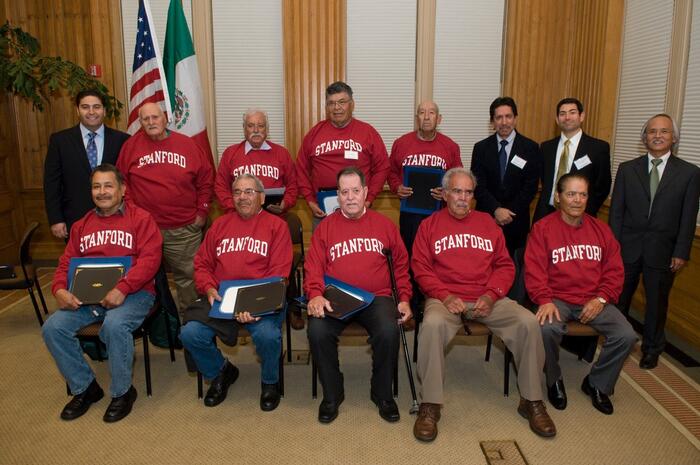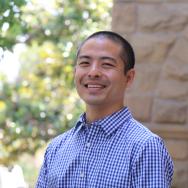Live Long and ProsperŌĆ” and Stand Back
In his March 15, 2021 lecture for 91│į╣ŽŌĆÖs Reischauer Scholars Program, actor George TakeiŌĆöwho played Hikaru Sulu, helmsman of the USS Enterprise in Star TrekŌĆöadded ŌĆ£and Stand BackŌĆØ to the iconic Star Trek words, ŌĆ£Live Long and Prosper,ŌĆØ as he was greeting students. His addition of ŌĆ£and Stand BackŌĆØ was a message to the RSP students that it is important to continue to socially distance during the pandemic.
During his riveting lecture, Takei didnŌĆÖt need to draw upon his acting skills to engage his audience of students as he recollected his familyŌĆÖs life after the Japanese attack on Pearl Harbor on December 7, 1941, and drew parallels between his familyŌĆÖs experience during World War II and anti-Asian sentiment and hate crimes (including killings and stabbings) against Asian Americans today. Takei was four years old at the time of the Pearl Harbor attack, and following the signing of Executive Order 9066 by President Franklin Roosevelt on February 19, 1942, Takei and his family along with approximately 120,000 people of Japanese descentŌĆötwo thirds of whom were American citizens like TakeiŌĆöwere forced from their homes.
As he did with his legions of fans in Star Trek, Takei had the students glued to their screens as he recalled the day that he and his family were forced from their home in Los Angeles.
On that day that I can never forget, I had just turned five years old. It was a few weeks after my birthday, April 20. My father had gotten us dressed up hurriedly and told us to wait in the living room while my father and mother did some last-minute packing in the bedroom. Our baby sister was an infant and she was in the bedroom with them in a cradle. In the living room, my brother and I were just gazing out the front window at our neighborhood and suddenly we saw two soldiers marching up our driveway. They carried rifles with shiny bayonets on them. They stomped up the front porch and with their fists, began pounding the door. I still remember how it felt, like the walls were tremblingŌĆ” My father came out of the bedroom, answered the door, and literally, at gunpoint we were ordered out of our homeŌĆ” Shortly after and escorted by one of the soldiers, my mother came out holding our baby sister in one arm and a huge duffle bag in the other, and tears were streaming down her cheeks. The terror of that morning is still alive in me. I will never be able to forget that horrific day. It is seared into my memory.
Upon hearing this, RSP student Kogen Brown reflected, ŌĆ£I was deeply struck by the fact that these details remained in Mr. TakeiŌĆÖs mind after all these years. I remember only a few snippets of my life from that age, and the fact that he remembers so many specific aspects about the time that he was interned really goes to show the emotional and psychological impact that internment had on Japanese AmericansŌĆöeven those who were so young that they didnŌĆÖt know what was happening or why it was happening to them.ŌĆØ
The War Relocation Authority (WRA) was the federal agency created in 1942 to oversee the Japanese Americans who were removed from the West Coast during World War II. The WRA built and operated a network of camps, where those removed were subjected to forced incarceration. Takei and his family were taken to the horse stables in Santa Anita Racetrack where they were assigned to a horse stall, which was still pungent with horse manure. The family stayed for four or five months in the so-called Santa Anita Assembly Center while the more permanent concentration camps were being built. From Santa Anita, Takei and his family were sent by train to the so-called Rohwer War Relocation Center in Arkansas. Takei recollected, ŌĆ£There, as a five-year-old child, I had an adventure. A discovery of a whole alien world. I am a southern Californian. IŌĆÖm used to palm trees. In Rohwer beyond the barbed wire fence was the bayou. I have memories of camp as a fun experience, but that was a childŌĆÖs experience. At the same time, parallel to my childhood experience, my parents had a grotesque experienceŌĆöbarbed wire fences, sentry towers, machine guns pointed at them. When we made the night run to the latrine from our barrack, searchlights followed us. My mother considered it an invasive, humiliating light but the five-year-old me thought it was nice that they lit the way for me to pee. Same experiences but two different memories.ŌĆØ
During his recollection of his life during World War II, Takei noted, ŌĆ£There are relevant lessons that apply to whatŌĆÖs happening today. We talk about Asian hate, hate of Asian people, and horrific things are being done to elderly Asians because of the pandemic we are going through. This kind of hate is what Japanese Americans were subjected to more than 80 years agoŌĆ” back then, graffiti was painted on some of our homes, on our carsŌĆ” like whatŌĆÖs happening today.ŌĆØ
Takei underscored the ironies of being detained behind barbed wire. He noted,
ŌĆ£I still canŌĆÖt wrap my head around how horribly the U.S. government failed Japanese Americans,ŌĆØ reflected RSP student Kalia Lai, ŌĆ£Hearing from Mr. Takei that he and the other Japanese American students still had to say the Pledge of Allegiance at the start of school made me realize how empty those words, ŌĆświth liberty and justice for all,ŌĆÖ turned out to be for Japanese Americans, and how inhumane the incarceration camps were.ŌĆØ
Takei also shared that in 1943, the War Department and WRA established a ŌĆ£loyalty questionnaireŌĆØ as a means to assess the loyalty of all adults in the WRA camps. Takei spoke specifically about the final two questions, questions 27 and 28, which created confusion and resentment.
Question number 27 asked if Japanese Americans were willing to serve in the armed forces of the United States on combat duty wherever ordered. Question number 28 asked if individuals would swear unqualified allegiance to the United States and faithfully defend the United States from any or all attack by foreign or domestic forces, and forswear any form of allegiance or obedience to the Japanese Emperor, or any other foreign government, power, or organization. U.S. citizens resented being asked to renounce loyalty to the Emperor of Japan when they had never held a loyalty to the Emperor. At the time, Japanese immigrants were barred from becoming U.S. citizens, so they wondered if renouncing their only citizenship would leave them stateless.
Despite the confusion, thousands from Hawaii and the concentration camps served in the U.S. Army. The 442nd Regimental Combat Team was organized on March 23, 1943, after more than a year during which Americans of Japanese descent were declared enemy aliens by the U.S. War Department. Takei emphatically noted, ŌĆ£We werenŌĆÖt the enemy, we were Americans.ŌĆØ The 442nd RCT became the most decorated unit for its size and length of service in U.S. military history. Following the end of the war, President Truman honored them and said, ŌĆ£You fought not only the enemy, but you fought prejudiceŌĆöand you have won.ŌĆØ
Takei noted the importance for students to study about history as it teaches us important lessons and stated that he has made it his lifeŌĆÖs mission to talk about the incarceration of Japanese Americans. ŌĆ£As a matter of fact, today we are living through a time that will be studied as a very important part of history by future generations,ŌĆØ expressed Takei. Recalling his years behind barbed wire, he emphasized that he and his family were viewed with suspicion and hate simply because of the way they looked. ŌĆ£There were no charges, no trial, no due processŌĆ” Terror made toxic by racism started to affect the so-called leaders of our country, the politicians, but instead of leading, these politicians got swept up by the hysteria and became part of that hysteriaŌĆ” We have so much to learn from history because we are repeating the same kind of mentality that put us in these barbed wire prison camps.ŌĆØ
These words resonated in RSP student Noah Kurima, whose paternal grandparents were among the 120,000 who were incarcerated. Kurima commented, ŌĆ£What surprised me the most upon hearing Mr. Takei speak about his wartime experiences are the parallels that I see in our country eight decades later. As a 16-year-old, I would have hoped that more progress had been made in the area of cross-cultural understanding. The hysteria, racism, and failure of political leadership that Mr. Takei described from his childhood seem eerily similar to what I have seen in the media recently. I hope that the RSP students in the year 2100 will not be witnessing the same parallels that I am today.ŌĆØ
In a strongly emphasized message to the students, Takei said that the ideals of the United States ŌĆ£are noble but they become real and true only when the people infuse those ideals with truth with backing. At times of panic and hysteria, we start behaving irrationally.ŌĆØ
RSP Instructor Naomi Funahashi reflected, ŌĆ£I hope that my students especially take this message to heart. I honestly hesitated to close the session because of the clear impact that Mr. Takei was having on my students.ŌĆØ Funahashi gratefully acknowledged Takei and noted, ŌĆ£Sharing your recollectionsŌĆöparticularly those of you as a five-year-old boyŌĆöwe could feel your very palpable sense of terror and fear, and through your voice, you helped students to understand why itŌĆÖs such an important issue to study today.ŌĆØ
George Takei is a social justice activist, social media superstar, Grammy-nominated recording artist, New York Times bestselling author, and pioneering actor whose career has spanned six decades. He has appeared in more than 40 feature films and hundreds of television roles, and he has used his success as a platform to fight for social justice, LGBTQ+ rights, and marriage equality. For the full story of George TakeiŌĆÖs childhood imprisoned within American concentration camps during World War II, see his graphic memoir, . Naomi Funahashi and I are grateful to Brad Takei for his support of GeorgeŌĆÖs lecture and this article, and also to Michael Kurima for his support as a liaison between 91│į╣Ž and George Takei.
Read More
In his March 15, 2021 lecture for 91│į╣ŽŌĆÖs Reischauer Scholars Program, actor George TakeiŌĆöwho played Hikaru Sulu, helmsman of the USS Enterprise in Star TrekŌĆöadded ŌĆ£and Stand BackŌĆØ to the iconic Star Trek words, ŌĆ£Live Long and Prosper,ŌĆØ as he was greeting students.

 FSI researchers consider international development from a variety of angles. They analyze ideas such as how public action and good governance are cornerstones of economic prosperity in Mexico and how investments in high school education will improve ChinaŌĆÖs economy.
FSI researchers consider international development from a variety of angles. They analyze ideas such as how public action and good governance are cornerstones of economic prosperity in Mexico and how investments in high school education will improve ChinaŌĆÖs economy.






















